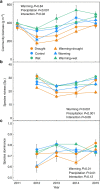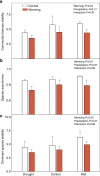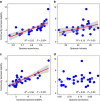Climate warming reduces the temporal stability of plant community biomass production
- PMID: 28488673
- PMCID: PMC5436222
- DOI: 10.1038/ncomms15378
Climate warming reduces the temporal stability of plant community biomass production
Abstract
Anthropogenic climate change has emerged as a critical environmental problem, prompting frequent investigations into its consequences for various ecological systems. Few studies, however, have explored the effect of climate change on ecological stability and the underlying mechanisms. We conduct a field experiment to assess the influence of warming and altered precipitation on the temporal stability of plant community biomass in an alpine grassland located on the Tibetan Plateau. We find that whereas precipitation alteration does not influence biomass temporal stability, warming lowers stability through reducing the degree of species asynchrony. Importantly, biomass temporal stability is not influenced by plant species diversity, but is largely determined by the temporal stability of dominant species and asynchronous population dynamics among the coexisting species. Our findings suggest that ongoing and future climate change may alter stability properties of ecological communities, potentially hindering their ability to provide ecosystem services for humanity.
Conflict of interest statement
The authors declare no competing financial interests.
Figures




References
-
- Pimm S. L. The complexity and stability of ecosystems. Nature 307, 321–326 (1984).
-
- Ives A. R. & Carpenter S. R. Stability and diversity of ecosystems. Science 317, 58–62 (2007). - PubMed
-
- Hooper D. U. et al.. Effects of biodiversity on ecosystem functioning: a consensus of current knowledge. Ecol. Monogr. 75, 3–35 (2005).
-
- Grman E., Lau J. A., Schoolmaster D. R. & Gross K. L. Mechanisms contributing to stability in ecosystem function depend on the environmental context. Ecol. Lett. 13, 1400–1410 (2010). - PubMed
Publication types
MeSH terms
Substances
LinkOut - more resources
Full Text Sources
Other Literature Sources
Medical

